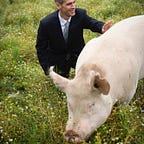The Magic Spear Theory of Aeneid 12
An End-of-the-Semester Challenge
Latin lovers! Here’s a challenge. You can do it by yourself, but it’s more fun with friends or groups of students. It’s based on a point Fred Ahl, my colleague, walked me through many years ago. Once again, he deserves credit (but no blame) for what follows.
Before you read to the end of this post, have everyone get a piece of paper and a pencil. Then, without discussing it, have each person read and then draw a picture of the climactic scene in Aeneid 12 where Aeneas hits Turnus with a spear and wins the duel. Give yourself three minutes — time it! — to complete the task.
Here’s the scene (12.919–927) in Fred’s translation:
And, as he [Turnus] hesitates still, Aeneas with javelin brandished,
Figures the odds of success with his eyes and, mustering his full strength,
Spins off a long-range shot. No boulder propelled from a taut-torqued
Catapult high on a parapet makes such a crack, and no lightning
Leaps with such crackling, thunderous peal. Like a whirling tornado,
Bearing the fury of death, that shaft rips open his corslet’s
Rim and the outer edge of his shield’s seven layers of protection,
Screams through the thick of his thigh. And Turnus, felled by the impact,
Drops to the ground on his knee; and his knee buckles under his hugeness.
For reference, here’s the Latin of the part in bold (924–6):
exitium dirum hasta ferens orasque recludit
loricae et clipei extremos septemplicis orbis; 925
per medium stridens transit femur.
Now, if you want to get this right you need to know what a corselet (lorica) is and looks like. It’s a shirt made of leather armor. Aeneas is typically wearing a brown one in the iconographic tradition.
Got your picture? Good. Take a quick break.
Now compare your picture closely to the trajectory of Aeneas’ spear as Virgil describes it. It passes:—
Is this what your picture shows? Why not?
The simplest way for this to work is to suppose that Turnus is facing away from Aeneas and Aeneas shoots him in the back. Fred points this out in an endnote:
Aeneas’ javelin pierces his corselet, his shield, then his thigh. Turnus is not facing his foe (or does not have his shield in front of him) when the shaft hits, and he is struck from behind.
Remember, too, that a spear isn’t a bullet fired point blank from a gun and its trajectory creates a more dramatic parabola, and you may even conclude Turnus is hunched over or on one knee with his back turned (hence the spear passing through his thigh). Virgil himself says Turnus was hesitating when Aeneas shot him.
This is just one of the many bombshells Fred tucks away in those endnotes. As usual, he doesn’t develop the implications for you, though it probably affects how you see the justice of Aeneas’ actions.
At this point, cognitive dissonance might be setting in. If the “shoots-him-in-the-back” scenario sounds impossible, you could save your drawing by invoking hysteron proteron or saying Virgil didn’t notice what he was saying or even that Aeneas’ spear was magic, like the bullet (as Oliver Stone called it) that hit JFK:
Of course, magic spears do exist in Latin literature; the hero Cephalus has one. But there’s no reason to think Aeneas borrowed it.
You might also explain the trajectory — I’ve seen it happen — by emphasizing that Aeneas threw it “like a whirling tornado.”
But if that sounds desperate, and now that it’s occurred to you, maybe you’ll agree the “shoots-him-in-the-back” scenario is at least as likely as what you drew at first.
Enjoy!
Michael Fontaine is a professor of Classics at Cornell University. See the article below for more of his work.
